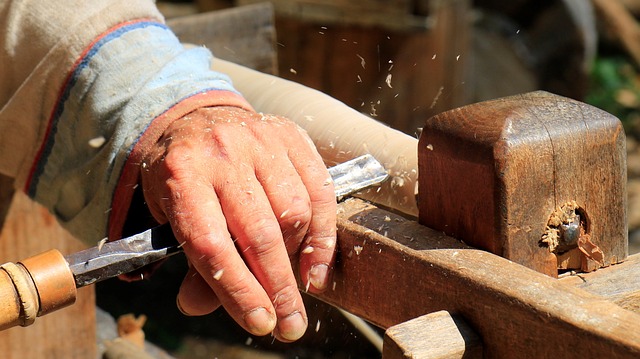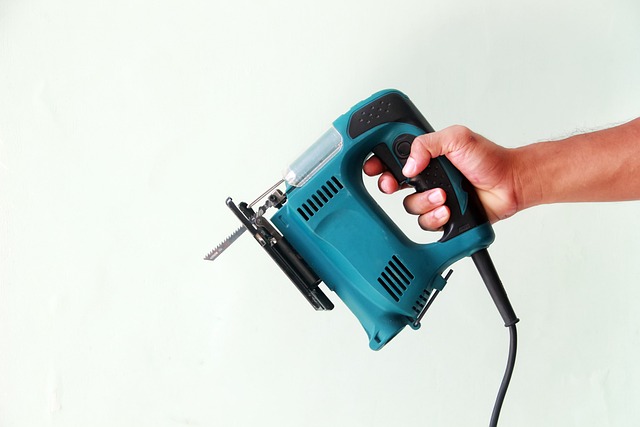Master carpenters are vital in maintaining and restoring historical wooden structures, blending traditional craftsmanship with modern conservation techniques. Their work involves a detailed assessment of each structure, aiming to preserve its original character while ensuring structural stability through informed interventions. The process requires a deep respect for the wood and the legacy of past artisans, incorporating time-honored joinery methods alongside state-of-the-art technology like moisture meters, infrared thermography, ground-penetrating radar, and 3D scanning to comprehensively evaluate the structure's condition. Carpenters carefully choose materials that match the original wood for seamless integration, employ precision tools, and use digital innovation for accurate restoration of both structural integrity and ornamental details. This approach ensures these architectural treasures are preserved with authenticity and meticulous craftsmanship, honoring their historical significance for future generations.
Preserving the legacy of historical wooden structures is an intricate craft that intertwines respect for the past with the precision of modern carpentry. This article delves into the meticulous art of restoring these gems, offering insights from master carpenters who navigate the delicate balance between upholding tradition and employing contemporary techniques to ensure longevity. Through a series of sections, we explore the critical assessments, essential materials and tools, cultural significance, and innovative approaches that form the backbone of historical wooden structure restoration. From the practical lessons of seasoned carpenters to the legal safeguards and ethical considerations, each aspect is examined to provide a comprehensive guide to preserving our wooden heritage for future generations. Join us on this journey through wood and time, as we celebrate the craftsmanship and community spirit that breathe new life into antique structures, ensuring they stand tall for centuries to come.
- The Art of Historical Wooden Structure Restoration: A Master Carpenter's Perspective
- Assessing the Integrity of Antique Wooden Structures: Methodologies Used by Expert Carpenters
- Materials and Tools Essential for Preserving Historic Wooden Buildings
The Art of Historical Wooden Structure Restoration: A Master Carpenter's Perspective

Master carpenters play a pivotal role in the preservation of historical wooden structures, a craft that marries traditional techniques with modern conservation methods. The intricate process of restoration begins with a meticulous assessment of the structure’s condition, with carpenters examining every plank and joint to understand its history and determine the necessary interventions. This careful evaluation is crucial for planning interventions that stabilize and reinforce the structure without compromising its integrity or original character.
The artistry involved in this endeavor transcends mere repair work; it requires a deep respect for the materials and the craftsmanship of past generations. Skilled carpenters employ a variety of traditional woodworking skills, from hand-cut joinery to precise fitting, ensuring that any new work seamlessly blends with the existing structure. This approach not only maintains the visual appeal but also ensures the longevity of these architectural treasures. The master carpenter’s perspective is one that values the continuum of time and craftsmanship, recognizing that each restoration project is a dialogue between history and preservation, with every nail and beam serving as a testament to the enduring legacy of skilled woodworking.
Assessing the Integrity of Antique Wooden Structures: Methodologies Used by Expert Carpenters

Expert carpenters employ a multifaceted approach to assess the integrity of antique wooden structures, ensuring their preservation and restoration are conducted with precision and care. The initial step involves a thorough visual inspection to identify obvious signs of decay, such as wood rot, insect infestations, or structural distortions. This is complemented by non-invasive techniques, including the use of moisture meters to detect hidden dampness, which can compromise the structural integrity of the wood over time. Infrared thermography might also be employed to locate areas with different moisture contents, aiding in the pinpointing of decay beneath surfaces that appear intact.
Furthermore, these skilled professionals often utilize advanced imaging technologies, such as ground-penetrating radar or 3D scanning, to analyze the internal condition of the wood without causing damage. This allows for an understanding of the structure’s overall health, including any hidden cracks, warping, or previous repairs that could affect the building’s longevity. The data collected from these assessments are critical in planning the restoration process, ensuring that each wooden element is treated according to its specific needs and the historical significance of the structure. Carpenters with a deep knowledge of traditional joinery and woodworking techniques work alongside conservation specialists to implement the most appropriate methods for the task at hand, all the while adhering to the highest standards of craftsmanship and preservation.
Materials and Tools Essential for Preserving Historic Wooden Buildings

Craftspeople and carpenters tasked with preserving historic wooden buildings must possess a deep understanding of both traditional and modern techniques to ensure the longevity and integrity of these structures. The choice of materials is paramount, as they must be compatible with the original construction while providing durability and resistance to environmental factors. Typically, materials such as wood that closely match the species, grain, and aging process of the existing structure are selected. This ensures visual coherence and structural stability.
The tools and equipment employed in this meticulous endeavor range from hand tools like chisels, planes, and hammers to power tools and machinery designed to handle wood without causing damage. Carpenters use microscopic adhesives for bonding timber, heat guns for softening old sealants, and air abrasion tools for stripping paint layers without affecting the underlying wood. Digital technology such as laser scanners can capture every detail of the building, aiding in the restoration process by providing precise measurements and documentation. This technological integration allows for more accurate replication of ornamental elements, ensuring that each aspect of the historic structure is preserved with care and precision. The carpenter’s skill in selecting appropriate materials and employing both traditional and modern tools is essential in maintaining the authenticity and longevity of these treasured wooden structures.
In conclusion, the meticulous restoration and preservation of historical wooden structures are a testament to their enduring significance. The expertise of master carpenters in assessing structural integrity and selecting appropriate materials and tools is paramount. Through careful interventions, these time-honored edifices are not only brought back to life but also safeguarded for future generations. The nuanced approach to maintaining the authenticity and character of these structures underscores their value as cultural landmarks. Preservation efforts, guided by skilled carpenters, ensure that the legacy of these wooden marvels is preserved in a way that honors both their historical context and structural integrity.
